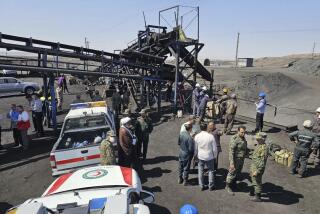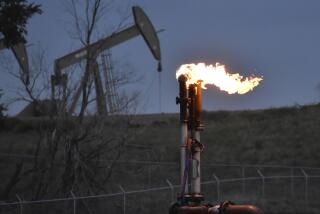Coal mines’ gas problem
- Share via
Mining coal is much like working in a natural gas well.
The same things that produce coal and oil -- dead organic material, heat and pressure -- also produce natural gas, whose primary constituent is methane. The gas is trapped in a coal seam or petroleum reservoir by pressure and water, only to be released when workers drill into the strata.
“It’s a tremendous nuisance,” said mining engineer Christopher J. Bise of West Virginia University. “It’s colorless, odorless and tasteless, but highly flammable.”
The gas is explosive at concentrations of 5% to 15% in the air, with the most violent explosions occurring at concentrations of about 9%.
The traditional way of dealing with the gas is “to overwhelm it with fresh air,” Bise said. Massive exhaust fans at some mine entrances suck air out of the shafts, pulling fresh air in through other entrances and circulating it through active mining areas.
Federal rules require that concentrations of methane in mines be kept below 1%. If it rises above that, mining operations are shut down until lower levels can be restored.
Most heavy equipment used in mines has a built-in sensor that shuts down power automatically if methane concentrations rise above 1.5%. Operators are supposed to report such shutdowns to supervisors, but that sometimes doesn’t happen because the workers’ pay is linked to their productivity.
The amount of methane released from coal depends on the grade of the coal and the depth of the mine. The deeper the mine or the higher the grade of coal, the greater the amount of methane.
The gassiest mines in the United States are deep, bituminous coal mines in Alabama’s Black Warrior Basin and in the western part of Virginia.
Some coal companies have recently begun programs to mitigate methane risk by drilling into the coal seams and pumping out the methane before mining starts. The methane is then sold to natural gas companies to be put into pipelines, providing the coal-mining companies a return on their investment.
Contrary to common belief, miners did not carry canaries into mines to give warnings about methane. Rather, they were used to monitor oxygen concentrations.
“If there was less than 16% oxygen in the air, the canary keeled over and miners knew to get out of there,” Bise said.
To measure methane, early miners used a flame safety lamp, a small device with a wick to burn naphtha fuel. If unusual concentrations of methane were present in the air, the flame would burn higher. Mining engineers were taught in school how to estimate methane concentrations by gauging the height of the flame.
Today, of course, methane levels are monitored electronically.
Although many experts believe that methane was responsible for the West Virginia explosion, it is not the only threat in such mines, according to mining engineer David Summers at the Missouri University of Science and Technology in Rolla. Finely powdered coal dust -- and many other fine powders -- can also be highly explosive, as witnessed by the occasional explosions of grain elevators produced by dust from the grain. It is more explosive than methane, Summers said.
Typically, the machines that mine coal have large rotating wheels with picks that break coal loose from the face of the seam. They also produce fine coal dust that disperses in the air. If the picks strike a stone in the coal, the resulting spark can ignite any methane that has been released in the immediate area, and the coal dust would exacerbate the blast.
To minimize risk from coal dust, federal laws require that an incombustible material such as powdered limestone be sprayed on the roof, ribs and walls of mines to within 40 feet of the mining surface. It adheres to small particles of dust and helps quench an explosion or prevents coal dust from fueling one.
It is a little known fact, then, that the interiors of most coal mines are white, not black, Bise said.
More to Read
Sign up for Essential California
The most important California stories and recommendations in your inbox every morning.
You may occasionally receive promotional content from the Los Angeles Times.










